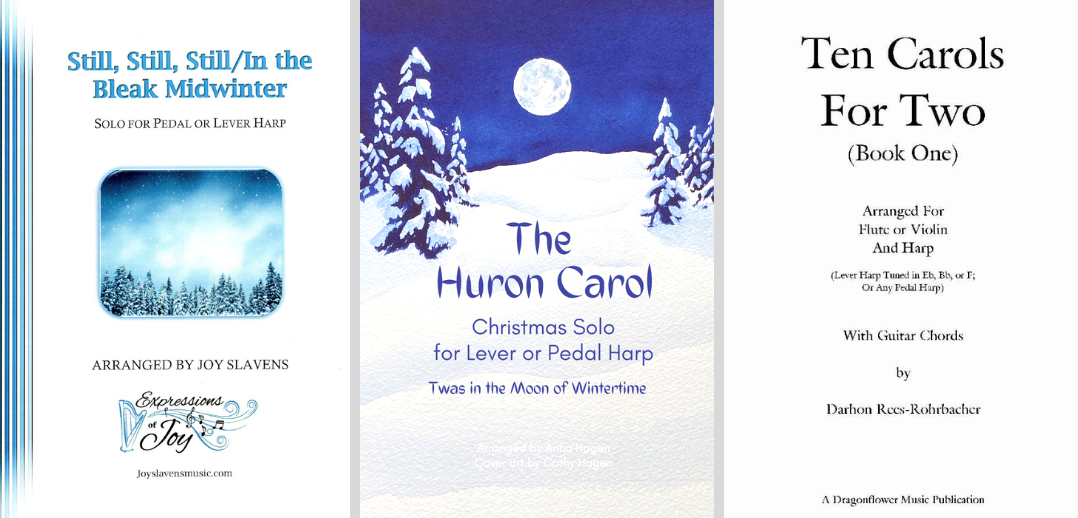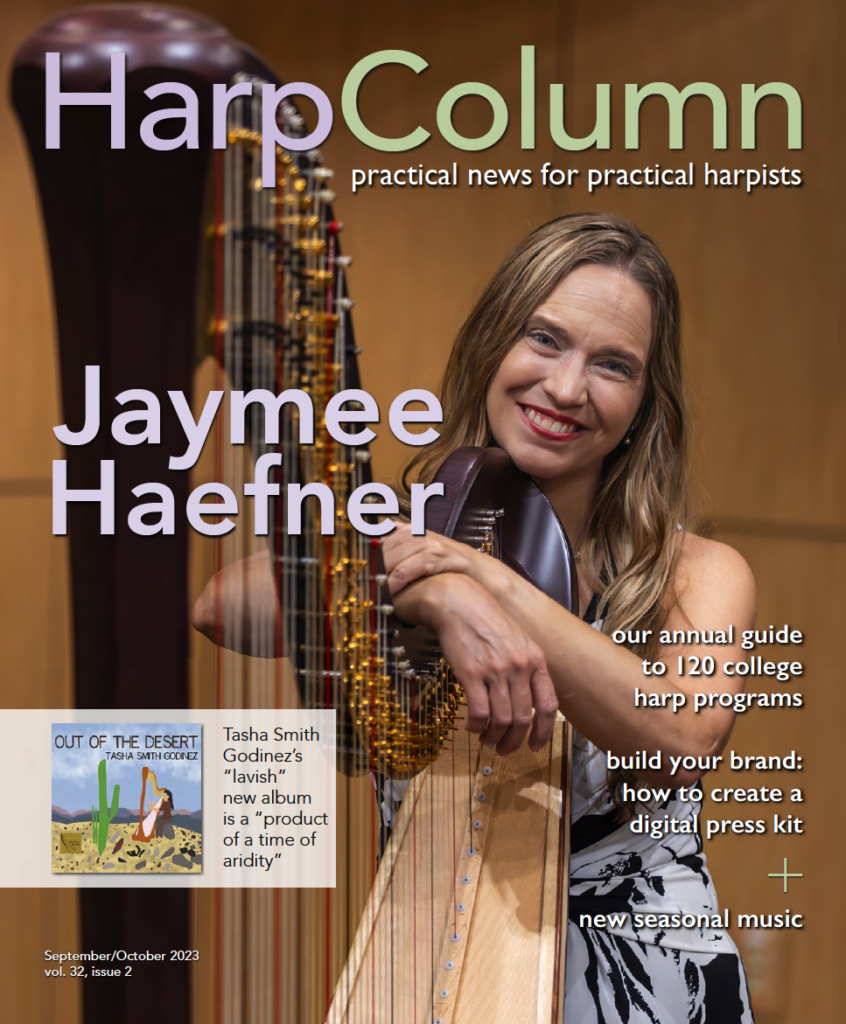
New arrangements of seasonal tunes include (from l. to r.) Joy Slavens’ medley for solo harp, Anna Hagen’s solo arrangement of “The Huron Carol,” and three volumes of Christmas duets from Darhon Rees-Rohrbacher.
Many of us are still experiencing sweltering heat, but the holidays will be here before you know it. There are some new publications for solo harp as well as duets for harp and flute or violin that are readily playable and you may find useful in the upcoming holiday season.
Joy Slavens (joyslavensmusic.com) has self-published a medley of “Still, Still, Still” and “In the Bleak Midwinter.” There is a solo harp version (for pedal or lever harp) as well as a duet for harp and flute or violin. Both publications are in E-flat and there are no pedal or lever changes. She had previously published a duo harp version (reviewed in the September/October 2021 issue of Harp Column).
The solo version begins with a four measure intro using eighth notes played in the left hand in a pattern that is repeated in the right hand an octave higher. “Still, Still, Still” is the first melody presented. Slavens uses mostly half note chords or a pattern of eighth notes for left hand accompaniment. The right hand is mostly a single note melody with chords added on the first beat. There are two verses and several scale glisses. She will often follow one phrase with the next phrase jumping up an octave.
The four measure intro is repeated as an interlude before the beginning of “…Midwinter.” She uses étouffées in the left hand for the bridge. A second verse is mostly an octave higher than the first verse with some descending eighth notes played below the melody in the right hand. The interlude is repeated once again before briefly restating the melody of “Still…” Several scale glisses are used to conclude the piece.
Fingering is suggested in a few places, but it is largely unnecessary as the notes fall logically within the hands. Intermediate players can easily sight-read this music.
The duet version for harp and flute is even easier, so it’s very sight-readable. The two instruments trade off playing the melody and it is pretty much the same format as the solo version.
These two carols are very compatible so you may find yourself wishing Slavens had interwoven the melodies a bit more. Nevertheless it is a nice combination and the bones are here for those who like to embellish further.
There is also a new self-published arrangement of “The Huron Carol” (a.k.a. “’Twas in the Moon of Wintertime”) by Anna Hagen. There are no lever or pedal changes and it is in E-minor.
The first verse uses a single note melody in the right hand accompanied by a steady, pulsing left hand pattern in the bass that Hagen describes as a “heartbeat.” The second verse is played an octave higher and the left hand pulse is replaced with intervals of thirds and other simple, single note patterns. The final verse moves back down an octave and features some left hand octaves played with an open hand to muffle. The heartbeat returns at the end.
Some fingering is suggested and the type-setting is easy to read. You can listen to Hagen playing the arrangement on YouTube. This is a fairly easy arrangement of a less common but engaging melody.
Darhon Rees-Rohrbacher has three new volumes of Christmas duets for harp (lever or pedal) and melody instrument (flute or violin). Ten Carols for Two are Dragonflower Music arrangements that are published by Afghan Press. All three volumes can be purchased as a PDF digital download or in a paper book. Each book is a mix of traditional carols and some lesser known tunes.
Lever harps must be tuned to E-flat, B-flat, or F. Each carol can be played individually, but the music is organized to facilitate lever changes between each piece so you can play straight through the book as a set. At the end of each piece she notes what levers need to be prepared for the next song. If they are just random accidentals, she also includes a diamond-shaped note at the beginning of the next song in case you are playing them separately. Lever changes within a piece are rare. Pedal harpists will have to move a few pedals, but they are easy changes and marked below the staff.
The flute part is included on the harp score but there is also a separate flute score. Guitar chords are included and allow the harp player to embellish their part as desired. Each piece is only two pages in order to avoid page turns, so there are numerous repeats and first and second endings. On several of the melodies, Rees-Rohrbacher includes instructions for the harp to simply play chords on the beat. Although the chord symbols are included, the chords are not written in. Some players may find it challenging if they are not used to reading lead sheets and choosing good chord voicing on the fly. Otherwise, most of the arrangements are quite simple but pleasing, and consist of primarily single notes in both hands. Intermediate players can sight-read this music, but since there are numerous written instructions there is a lot to digest before performing it in public.
Both instruments have an opportunity to play the melody, and there is a lot of trading back and forth, harmonizing, and counter-melodies. The arranger uses a few special effects here and there such as harmonics, scale glisses, muffling, grace notes, and playing lower on the strings.
There are videos of a few of the selections played by Rees-Rohrbacher on YouTube. If you get all three books you’ll have 30 duets to add your Christmas duet repertoire! •







